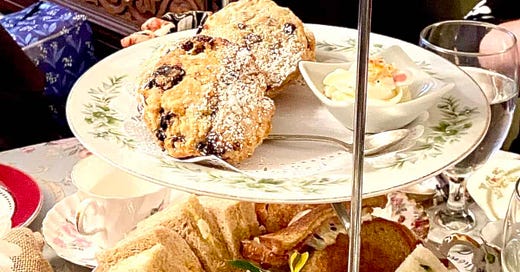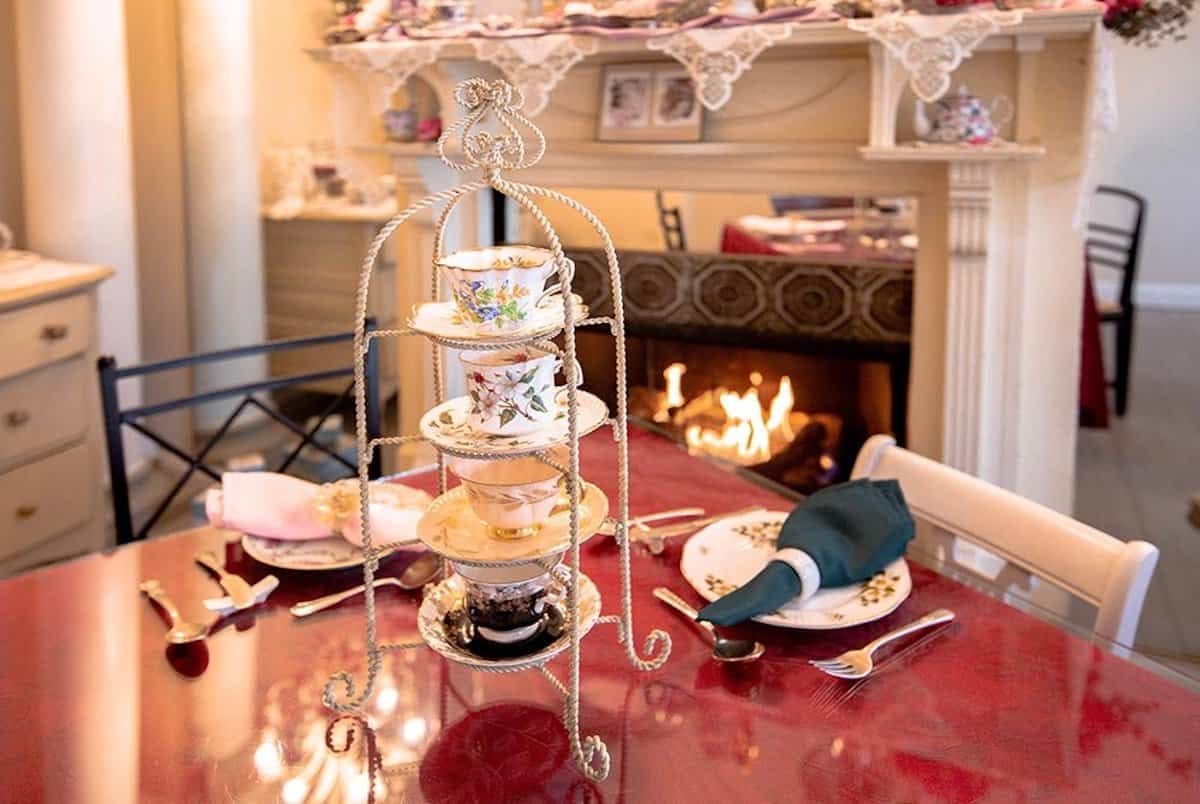Thinking of hosting or attending Afternoon Tea? Here's everything you need to know—from charming etiquette tips to its fascinating English roots.
A lovely afternoon at the Mathis House
Pinky's up! Just kidding — please don’t do that. Despite the stereotype, it's not proper tea etiquette.
Few customs are more iconic of England than Afternoon Tea. A few years ago, I enjoyed this tradition at the Mathis House, a lovely Victorian bed and breakfast and tea room in historic Toms River, New Jersey, voted one of New Jersey's top ten tea rooms.
We gathered for my niece’s bridal shower, sipping pots of tea and sharing scones, savory sandwiches, and sweets. The tea was served on fine china, and the company of family and friends, some of whom we hadn’t seen in years, made it even more special.
The history of Afternoon Tea
America has always been fascinated with British history and culture. Period shows like Downton Abbey and The Crown are popular, but I suspect the steamy Bridgerton Netflix series got younger adults' attention.
Afternoon Tea began in England in the 1840s with Anna, the seventh Duchess of Bedford. The Duchess would get hungry in the late afternoon.
Around this time, kerosene lamps were introduced in wealthier homes, and eating a late dinner became fashionable. This increasingly late dinner was one of only two meals each day. The other was a mid-morning, breakfast-like meal.
The story goes that to allay the 'sinking feeling' she felt in the late afternoon, the Duchess would order tea and cakes. The habit of snacking on small sandwiches and pastries accompanied by tea quickly caught on and became the famed Afternoon Tea.
The idea of an Afternoon Tea gathering spread across high society and became a favorite pastime for ladies of leisure. Later, it spread beyond the highest echelons of society and became more accessible to other socioeconomic groups. The British named it 'Afternoon Tea' for the satiating mid-afternoon meal served between 3 pm and 5 pm before the late evening dinner.
The difference between High Tea and Afternoon Tea
Traditionally, afternoon tea and refreshments—cakes, buns, pastries, and finger sandwiches—were served on low tables rather than at the dining table. Afternoon tea was initially called low tea.
When people hear the phrase 'high tea’, they often think it’s the same as Afternoon Tea, but it’s not. Afternoon Tea is typically served mid-afternoon and was traditionally served on low sofa or chairside tables.
So, what is high tea?
High tea is a working-class family evening meal made of hearty dishes and served on a high table, such as a dining room table, at the end of the workday, shortly after 5 pm.
High tea meals may include meat dishes such as steak and kidney pie, fish dishes such as pickled salmon, baked goods such as crumpets, and vegetables such as potatoes or onion cakes.
High tea was much more a working-class family meal than an elite social gathering. The working class did not have the leisure time for Afternoon Tea.
Afternoon tea etiquette
Afternoon Tea is served on a three-tiered tray of finger sandwiches, scones with clotted cream and jam, and sweet pastries served with tea. The first serving is always tea. Each guest selects their tea, and their teapot is brought to the table, which is sometimes kept warm with a cozy or candle warmer.
Some tea venues will serve soup. The soup course is served after the teapot and before the three courses.
The three-tiered tray separates the courses and follows a specific order:
The first course consists of savories and tea sandwiches
The second course is scones and jams with cream
The last course is sweets
The order of the tiers may change with different tea venues, but the eating order is always the same.
We enjoyed the Mathis House five-course Victorian Afternoon Tea:
A full Pot of Tea with over 80 gourmet varieties to choose from
A warm cup of home-made soup, seasonally prepared
A seasonal bowl of fresh salad
A plate of a variety of five traditional tea sandwiches and savories
Scone of the Day, served with clotted cream and lemon curd
A full plate of assorted finger-sized desserts
Pot of Tea
The pot of tea is served before the food comes out. It is already brewed and ready to drink. You will likely select your tea from an extensive black, green, oolong, and herbal tea menu.
First Course
Tea sandwiches are small, crustless, and bite-sized finger foods eaten as you would eat hors d'oeuvres. Classics include cucumber, egg salad, and smoked salmon.
Finish the tea sandwiches before moving on to the second course.
Second Course
Scones are served with British clotted cream and jam or lemon curd. Place the scone on your plate with small scoops of clotted cream and jam. Scoop a little of the cream and jam onto your plate using the spoons provided with the condiments. Don't use the serving spoons to put the jam or cream directly on your scone.
Use a knife to spread the cream and jam onto small, broken scone pieces. Then use your fingers to eat the scones.
Third Course
The sweets are usually mini pastries that can be eaten in 2-3 bites. Place your selections on your dish before eating, and do not eat from the serving tray.
Where to find afternoon Tea in the United States
Afternoon tea is experiencing a delightful resurgence across the United States. Although it’s not a daily ritual today, it is more common for Afternoon Tea to be enjoyed with a group of friends to celebrate a special event, such as a birthday, a pre-wedding party, or a baby shower.
If you’re looking for Afternoon Tea venues, Angela Renals of Destination Tea maintains a fantastic directory with over 150 tea room reviews covering all 50 United States.
After moving to Georgia, Angela became hooked on Afternoon Tea, a popular tradition in the South. As a mother, she enjoyed the adult conversation and savored the short respite of the mini getaway. Afternoon Tea became her passion.
Afternoon Tea at home
Afternoon tea is a revered English tradition, and anglophiles can stage every stylish element of this cultural staple of British society at home.
Bridgerton fans can enjoy The Republic of Tea Collections of Bridgerton Teas. The Republic of Tea also has a Downton Abbey line of teas.
The Official Downton Abbey Afternoon Tea Cookbook is an excellent little book with recipes for biscuits and scones, cakes and tarts, savories, preserves, and more. It contains everything you need to know to organize a proper afternoon tea and includes etiquette tips, serving ideas, and history that bring the experience to life.
The recipes capture the quintessential delicacies of the time with the correct way to serve them. You will also find classics like:
Battenberg Cake
Bakewell Tart
Coffee puddings
Cream scones
Tea sandwiches
The book also has gorgeous food photographs that bring this rich tradition to life.
You may not always have the opportunity to experience this lovely custom, but if you do, I highly recommend it.
Try a small hotel or boutique tea house and bring friends and good cheer. Talk, drink a little tea, and eat savories and sweets. Relax, laugh, and enjoy the tea and company. It’s a charming tradition.









You've highlight a few quality loose-leaf tea outlets. I'm not American nor live in the US, but am obviously a tea lover. I have to really commend you Americans on the quality of tea you serve in tea rooms. I went to a couple in Pasadena, CA last year. I even purchased some loose-leaf teas to bring home. The prices were reasonable enough, and the quality was superb. I like flavoured black tea. I found the teas had a good body and nice aroma/taste. Thank you for all your lovely sharing.
I experienced an afternoon tea at with my daughter-jn-law and granddaughter at The Brown Hotel in Denver, Colorado. It was an awesome experience.